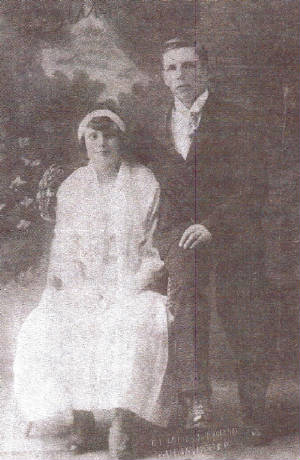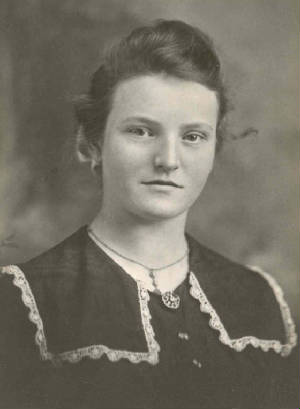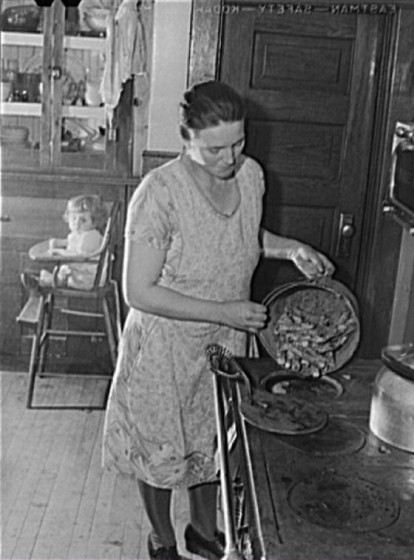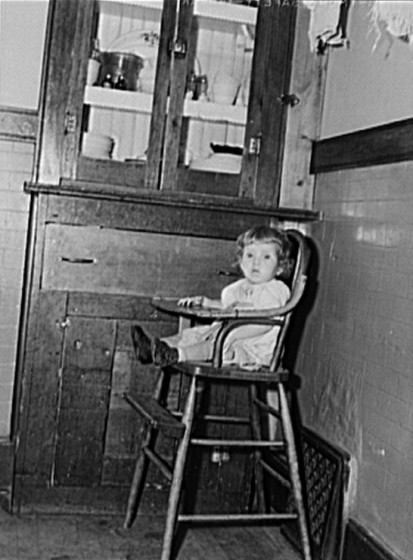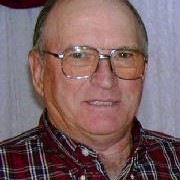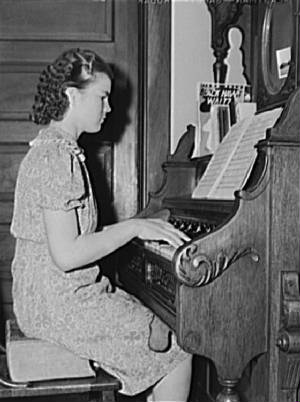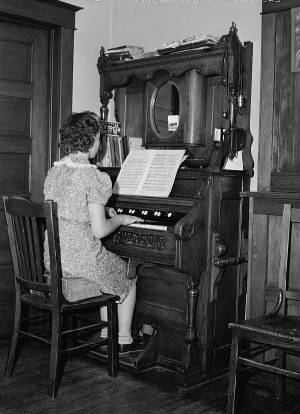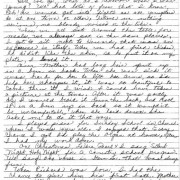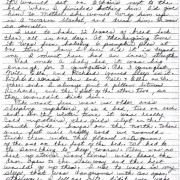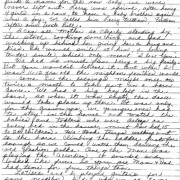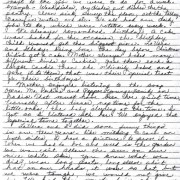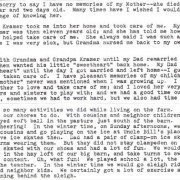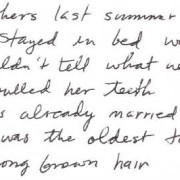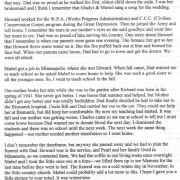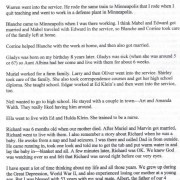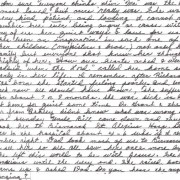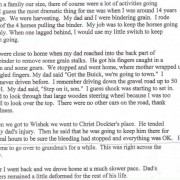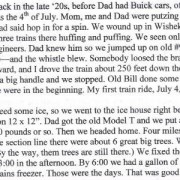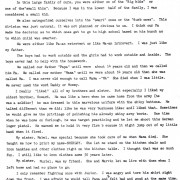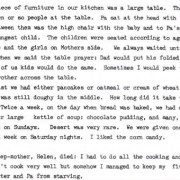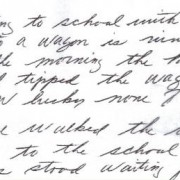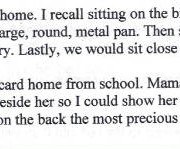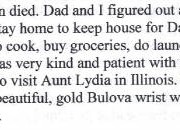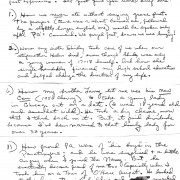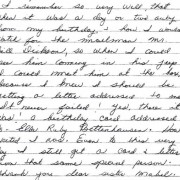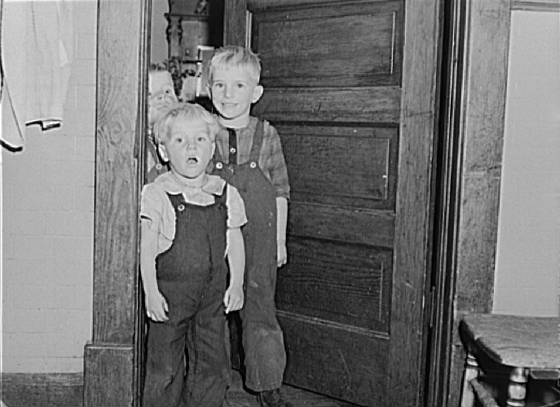
John Vachon caption: Bettenhausen children. McIntosh County, North Dakota. November 1940.
“Oliver Jr., Neil and I always seemed to be working with Dad’s tools in the workshop. Even after many reminders not to get into ‘my tools,’ we managed to go to the tool shop and try to build something to play with. Of course, we would never pick up afterwards and always left a mess – wood scraps or whatever we happened to be working on. Consequently all Dad had to do was open the door and there was all that mess. Usually the end result was a real tanning of the behinds.” -Edgar Bettenhausen
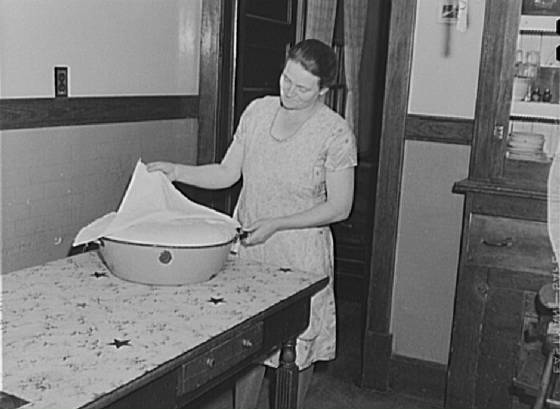
John Vachon caption: Mrs. Bettenhausen with bread she is baking. McIntosh County, North Dakota, November 1940.
“The photos are really precious. I was eight months old when she died, so these are really significant pictures. For nearly my entire life, I’ve been putting bits and pieces together of what my mother was really like.” -Richard Bettenhausen
“I’ve often wondered what my mother was like. All I remember is somebody (I think it was Blanche) lifted me up so I could see her in the casket. I envy my older brothers and sisters who remember her.” -Neil Bettenhausen
“The Farm Security Administration from the beginning of its operation through last Dec. 31, had certified rehabilitation loans totaling $9,241,182 to 26,039 North Dakota families, and grants amounting to $19,650,018 to 52,558 North Dakota families. For the purchase of farms it had made loans totaling $343,811 to 56 North Dakota tenants. –Bismarck Tribune, March 11, 1940
“In grim terms of suffering and want the Farm Security Administration warned thousands of Midwestern farm families Thursday against migrating to the Pacific coast in search of economic opportunity. ‘There already is a considerable surplus of farm labor in that area,’ the FSA wrote its clients in Arkansas, Kansas, Missouri, Oklahoma, and Texas, ‘and most of the migrant families can find work only at irregular intervals. As a result, their annual earnings usually are extremely low, and suffering from lack of proper food and clothing had been widespread. In many cases these families have no homes except temporary camps along the roadside, often without a good water supply or even the most primitive sanitary facilities.'” -Bismarck Tribune, March 29, 1940
“My deepest and strongest and fondest memories of working there (Farm Security Administration) for five years I guess, six, something like that, are all connected with traveling around this country, seeing places that I’d never been to before. I had traveled very little until that time. I’d only been from my native Minnesota to non-native Washington (DC), and it was just great to be alone in a car and to be paid for driving around and taking pictures of what you liked to take pictures of.” -Oral history interview with John Vachon, April 28, 1964, Archives of American Art, Smithsonian Institution
John Vachon took hundreds of photographs in the Dakotas in 1940. In November he was in McIntosh County, which is just above the South Dakota line. His general assignment was to take pictures of farm life, and of families who were applying for, or had received loans and grants from the FSA. Unfortunately, it was common for FSA photographers to offer few details in the captions, leaving viewers wondering who the people were and why they were chosen. In this case, among a total of 11 pictures of the family, only Mrs. Bettenhausen (no first name) was identified, and there was no mention of the family receiving a loan or other assistance.
Nevertheless the photographs are endearing portraits of the routine lives of a modest farm family that was dealing with what would be the latter days of the Great Depression, and were facing the increasing possibility of their country becoming involved in a war in Europe. Thirteen months later, the Japanese would attack Pearl Harbor. What we don’t know is that (Emma) Bettenhausen had already given birth to 15 children, that she was about four months pregnant, and that she would die of cancer eight months after the child was born. Within days after I saw the pictures, I had already talked to Neil, the youngest boy in the photo at the top, and Richard, the child who Emma was carrying when Vachon made his visit 72 years ago this month (November 2012).
The children had seen several of the photos in a book called The Years of Despair, North Dakota in the Depression, published in 1973. But as a result of my inquiry, they learned of all the others, most of them pictures of their mother, whom the younger children barely remember. They are the only significant photographs of the family taken at that time, an inadvertent bequest from the great Mr. Vachon (1914-1975).
I conducted a long interview with Richard, who has become both the family historian and the organizer of what has become a long string of reunions every five years. He provided me with family photos and copies of Childhood Memories, which are reunion booklets containing a treasure trove of sentimental and richly detailed stories and anecdotes of the family’s daily lives, written by the children. They include loving and often heartbreaking testimonials to their mother. I have posted a great deal of this on the following pages.

John Vachon caption: Mrs. Bettenhausen with canned goods in cellar. McIntosh County, North Dakota, November 1940.
“Oliver Wesley Bettenhausen was the third son of Christian C. Bettenhausen. He came to North Dakota in June of 1909 as a hired man for his brother, William H. Bettenhausen. After a year and a half he struck out on his own working for a number of other big farmers, namely Mullkins, Gillis and Firr, running a big tractor for $175.00 per year. He also taught school for a year.
In 1910 his dad bought 320 acres of land in Section 10-131-72, and this is the home place. He married Paulina Kramer January 1, 1917. She was born in Kassel, Russia on December 12, 1899. One daughter, Pearl Loretta Bettenhausen, was born to them on October 28, 1917. Paulina died October 29, 1918, and is buried at Beaver Creek Baptist Cemetery.
Oliver remarried to Emma Grace Kramer (Paulina’s sister) on July 1, 1919 at Fredonia, North Dakota. Rev. Fox officiated. Emma was born June 10, 1903 in North Dakota. Sixteen children were born to them, eight sons and eight daughters. Oliver and Emma were farmers all their lives and were members of the Baptist Church.
Their children are: Howard Ervin, LaVera Florence, Mabel Grace, Charles Christian, Warren Justus, Blanche Estela, Corinne Adeline, Gladys Lydia, Muriel Betty, Larry William, Oliver Wesley Jr., Shirley Emma, Edgar George, Neil Benjamin, Ella Ruby and Richard Arthur. Emma passed away on November 6, 1941, Oliver passed away on August 3, 1971. They are buried at Beaver Creek Baptist Cemetery one half mile west of the home place farm, SW-SE4-Sec. 4-131-72.” -Quoted from reunion booklet
Note: Oliver was born in Illinois on April 5, 1895. His mother’s name was Christina (Holstien) Bettenhausen. Oliver married a third time, in 1946, to Helen Konopacky. There were no children. She died in 1950.
John Vachon captions: (Left): Mrs. Bettenhausen using corn cobs for fuel. McIntosh County, North Dakota, November 1940.
(Right): One of the Bettenhausen children. McIntosh County, North Dakota, November 1940.
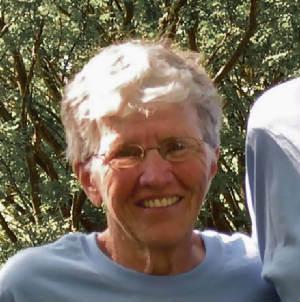
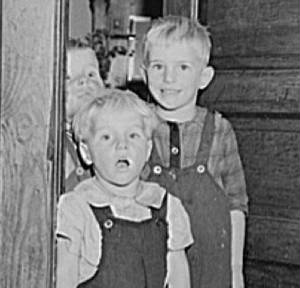

Edited interview with Richard Bettenhausen (RB), youngest child of Oliver and Emma Bettenhausen. Interview conducted by Joe Manning (JM) on September 11, 2012.
JM: When did you first see the photos?
RB: About 10 years ago.
JM: Were you already aware that your family had been photographed by the government back then?
RB: No one ever said anything about it.
JM: Did you understand the significance of the photos?
RB: No, not at the time.
JM: How did you react to the photos?
RB: Having a lot of older siblings when I was growing up, I was somewhat aware of what life was like in those years prior to when I was born. But until I saw the photos, it was hard to picture what it was like. The photos really had quite an impact.
JM: Did you have family photographs that showed the same things?
RB: None that I know of. There were pictures taken, but that was later, probably the mid-forties.
JM: How did you react to seeing the photos of your mother? She died when you were just a baby.
RB: The photos are really precious. I was eight months old when she died, so these are really significant pictures. For nearly my entire life, I’ve been putting bits and pieces together of what my mother was really like. Having older sisters helped a little, because sometimes they would say something about her personality.
JM: What was your date of birth?
RB: March 20, 1941.
JM: A lot of the photos taken by the Farm Security Administration showed families that were getting assistance from the agency. Do you know if your family received help from them?
RB: I’ve never heard anything about it. The only thing I can tell you is that in the early 1930s, when the crops were non-existent, my understanding is that my grandfather Bettenhausen, who lived in Illinois at the time, helped my parents by paying the taxes on the farmstead.
JM: Did you grow up on the farm where your family was photographed?
RB: Yes.
JM: What was the primary output of the farm? Was it a crop farm or a dairy farm?
RB: A combination of small grains and livestock.
JM: Was there a center of town nearby?
RB: No, just farmland.
JM: How did your family acquire the property?
RB: The land had originally been homesteaded. About 1912, it became available. My dad had gone to North Dakota from Illinois to work for his brother, who was farming. With some help from Grandpa Bettenhausen, there were two quarters of land purchased. That’s 360 acres. That was a pretty good size farm in those days.
JM: What are your earliest memories of growing up on the farm?
RB: We didn’t have running water. One of the jobs the younger kids had was making sure there was water in the house. We would go to the well and pump some water and bring back a pail at a time. Being one of the younger ones, I got to help with the dishes after supper. That was a major job. We had a big table and lots of people eating at one time.
JM: Who cooked after your mother passed away?
RB: The older sisters. There were always older sisters in the house who did the cooking. I understand that some of them made pretty big sacrifices to jump into that role of being a homemaker.
JM: Did some of them have to postpone getting married?
RB: Yes. And by that time, World War II had started, and some had husbands or boyfriends away in the war.
JM: Did some of your brothers go off to war?
RB: Yes, I had two brothers that were in the war.
JM: Did both of them return safe and sound?
RB: Yes.
JM: Did any of your siblings move a great distance away while you were growing up?
RB: My oldest brother, Howard, had a career in the Army, and he never moved back to the area. Pearl, the oldest child, got married and lived about 100 miles from the homestead, which was a fairly long way in those days.
JM: Was their passenger train service nearby?
RB: Yes, the train was the Soo Line out of Minneapolis.
JM: What town would you go to when you needed supplies?
RB: Our home town of Wishek, which was about 10 miles away. That’s where we bought everything we needed. They had a grocery store and a hardware store.
JM: Between working the farm and going to school, did you have any time to do anything else?
RB: With all the kids in the immediate family, we played a lot of games, mostly outdoors. When the weather was nice, we’d play softball; in the wintertime, we’d play in the snow. There was always time for recreation, but Dad would demand that the chores were done first.
JM: Did you also have playmates that you knew from school?
RB: Most of my schoolmates lived a mile or so away, so I never played with them except on the school playground during the school year.
JM: Did most of the families in the area have a car?
RB: Yes.
JM: Do you remember having a lot of bad storms, the kind that the Plains is known for?
RB: I remember the blizzards. The thing that was significant back in those days is that you didn’t have four-wheel-drive vehicles, and the roads were pretty bad. There was hardly any snow removal equipment. When the roads got blocked, you had to have a team of horses and a sled. You’d take the cream and the eggs to town, sell them, and use that money to buy the groceries. My dad would take a team of horses and go five miles either to the east or to the north, to get to the state highways. They were usually open. Then he’d try to catch a ride with someone that was driving into town, or someone in town that he knew would come out and pick him up.
JM: Where did you go to school?
RB: I went to a one-room country school for my first eight years. Rosenfield District was the home district. There were four schools in each township. We lived halfway between School No. 1, and School No. 2, so we vacillated between them, depending on how many students were in each school. Then I went to Wishek High School.
JM: How many of the children went to college?
RB: About five or six of us. None of the older ones went to college.
JM: How did they afford it?
RB: The ones that were in the service got the GI Bill, and they went to state schools. Others got a job and paid their own way.
JM: Did you go to college?
RB: I went two years at a vocational-technical school right after high school. I got an associate degree in electronics.
JM: When you were growing up, one of the few connections you had to the outside world was the radio.
RB: And the US Mail. We always waited anxiously for that mail carrier to come by.
JM: Did your family listen to the radio a lot?
RB: Only on special occasions. My father would always listen to the six o’clock news. He probably started doing that during the war. The older siblings would be out in the barn doing the chores. Sometimes in the evening, when all the chores were done, especially in the wintertime when it was dark and everybody was inside, we’d listen for maybe an hour or so.
JM: What was the easiest way for your father to keep track of changing farm prices and other farm news?
RB: Probably the radio, but my dad also subscribed to the Bismarck Tribune.
JM: Where did you go to church?
RB: When I was a little boy, we went to a Baptist church out in the country. It was a little less than a mile from our home. It closed in the late forties, and then we went to the church in Wishek.
JM: Did your father speak German?
RB: Yes. The common language in the entire community was German. I remember that when I was young, the church service in Wishek was in German.
JM: This is a strange question, but did you grow up thinking you were different because you lived in North Dakota?
RB: I don’t think so, but probably because I didn’t have anything to compare it to.
JM: I often wonder if people who grew up in sparsely populated rural communities back then had any sense that they were isolated.
RB: I don’t think that anyone in our family felt that way. We knew that to a lot of people in the rest of the country, North Dakota seemed like the end of the world, and that there was nothing there. But I never felt like I was different or less important because I lived there.
JM: How many of the children stayed in the Dakotas?
RB: About half of them, I think. If you count Minnesota, you can add a couple more.
JM: How many stayed in farming?
RB: Only three or four.
JM: Why so few?
RB: A lot of my sisters married people that were in the service, and their husbands, through the GI Bill, had opportunities to learn a different trade, and ended up living in cities.
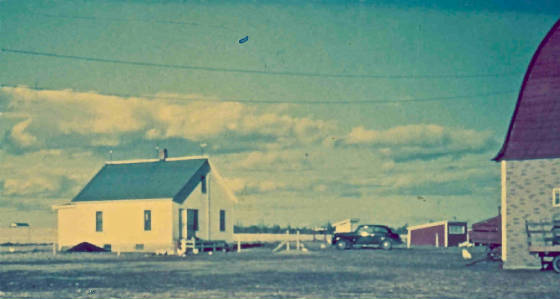
JM: Who owns the farm now?
RB: My nephew. My oldest brother, Charles, passed it on to him. He had bought the farm from our father in 1952.
JM: Did he change the farm?
RB: It stayed relatively the same. Later on, it became more of a livestock operation. Many of the original buildings are gone now but part of the barn and a granary/tool shop remain.
JM: Is it still 360 acres?
RB: Yes.
JM: How old is your nephew?
RB: About 60.
JM: Does he have children, and are they planning to take it over at some point?
RB: No, it doesn’t look that way. They’re already grown and some have gone away to live in other places.
JM: Why do you live in Rapid City?
RB: I got a job out here. When I graduated from vocational school, I got a job with Northwestern Bell Telephone, in the northern part of South Dakota. And then they transferred me to Rapid City. I spent my entire career in the state.
JM: How far are you from the old farmstead?
RB: About 325 miles.
JM: Do you get back much?
RB: At least once a year, but not as much as I used to. I have one brother and a sister-in-law in Wishek who are still alive. There are 13 of us left, and they are pretty much scattered all over the place now.
JM: What was it like having so many children in the house at one time? You wouldn’t have had any privacy. Was there ever a time when you thought, ‘Where can I go to get away from this?’
RB: That’s exactly right. I guess at the time I was so used to it that I never thought about it.
JM: How many people would be sleeping in the same room?
RB: The little farmhouse had two good size rooms upstairs. One was the boys’ bedroom, and the other was the girls’ bedroom. Each of those rooms had two double beds. I remember sleeping in a bed with three of my brothers. That was not unusual in those times. It sure kept you warm in the wintertime.
JM: Did you have indoor plumbing?
RB: No. We didn’t get it until just before my father sold the farm to my brother in 1952. That’s about when we also got rural electricity through the government subsidized REA program. But even before I was born, we had electric lights from a gasoline generator plant. That made us unique for the area.
JM: Did your father remarry?
RB: Yes. He married again in 1946. Her name was Helen. She was originally from Wisconsin. She was a great cook, and she kept everybody fed and happy. But she passed away in 1950. My sister Shirley took over being the mother of our family for the next year. She finished her senior year of high school via correspondence. What an undertaking for a 16-year-old girl. Soon after, Charles bought the farm and Dad moved into town. That summer in 1952, I went to live with my sister Muriel and her husband Marvin Schilling. Dad died in 1971.
JM: Does your family ever have a reunion?
RB: In 1960, we had the first Bettenhausen family reunion. It was in Wishek. Three of the children were still not married, and there were just a handful of grandkids. After that, we decided to do it once every five years, and that’s what happened. We had the last one in 2010. They’ve all been in Wishek. We usually have about 100 to 130 people. We’ve had the last five at a church campsite.
JM: Do you have children?
RB: We have twin daughters.
JM: Do they have any interest in the family history?
RB: Yes, very much so.
JM: It’s obvious that your family is very close. Do you think that has something to do with your mother dying young?
RB: I’m not sure. That’s an interesting question.
JM: What was your father like?
RB: He valued education. He was authoritarian. He ruled the family with an iron hand. But by the time I came along, he was 46 years old and had probably mellowed a little. My perception of him was that he was much gentler than some of my older siblings remember him being. He always wanted the best for his family.
JM: Did he ever talk about losing your mother?
RB: No, never.
JM: What did your siblings tell you about what your mother was like?
RB: Everything I know about my mother I learned from my older sisters. They said that she was very kind, quiet, and probably the opposite of my dad.
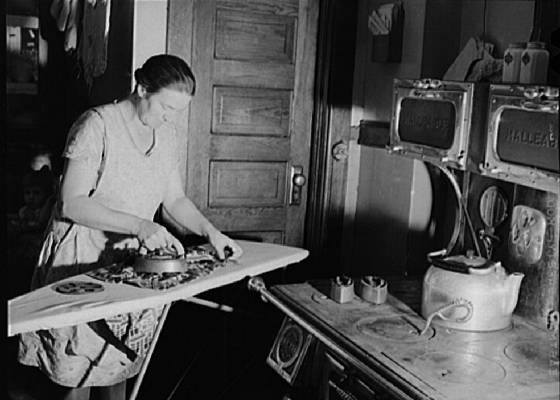
John Vachon caption: Mrs. Bettenhausen ironing. McIntosh County, North Dakota, November 1940.
JM: John Vachon took quite a few pictures of your mother doing household chores. She didn’t look self-conscious. She looked like she was content to do whatever she was doing, and that she wasn’t bothered by the camera. I think your mother was quite beautiful. She had an expression on her face that moved me, even before I found out that she died only a year after she was photographed.
RB: That’s exactly how my older sisters described my mother.
JM: In the photos, your house looked like it was well built. There’s a lot of nice woodwork. I noticed the chair rails.
RB: The house was built by my father, and I assume he had some friends who were good carpenters. It’s gone now. It was finally torn down. The original house had a coal burning furnace in the basement. Most of the houses in the area at that time just had space heaters. The coal would come into Wishek on the train, and we’d go in with a little old truck and haul loads of coal back home and put it in the large coal bin in the basement. That would last us all winter.
Sometime prior to when my dad passed away, I got involved in being a gatherer of information about the family. My wife and I used to go to Wishek to visit four or five times a year. As he got older, he became worried that the family was going to sort of go their own way and nobody would ever talk much to each other. He was very pleased about the family reunions. A few years after he passed, I took it upon myself to get a family newsletter started. So I sent out a notice about it to all my siblings. I still do that. As you suggested, maybe this is a result of our mother passing away early.
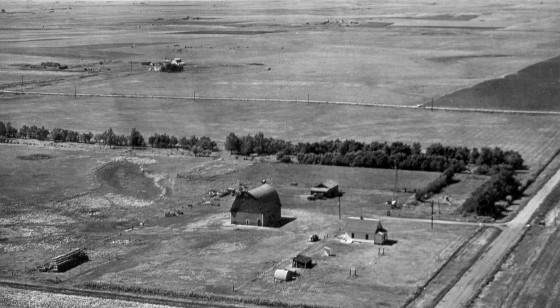
John Vachon captions (both photos): Farm girl playing organ in home. McIntosh County, North Dakota, November 1940.
“I remember our little organ in our home and the many evening hours we’d gather around, with Mabel playing for us, and we’d sing many songs: ‘Grandfather’s Clock,’ ‘Whispering Hope,’ ‘Jesus Loves Me,’ and ‘Star of the East.’ Our dad many times sang with us, so we had to behave.” -Blanche Bettenhausen
“I will always be grateful for our dad’s love of music. Often on Sunday evenings, after supper and when the dishes were washed, we gathered around the old pump organ to sing. Mabel would play for us. LaVera and Muriel would sing alto; Corinne, Blanche and I were sopranos. I’m not too sure I have that right – maybe Corinne was an alto, too. I also remember our dad playing the organ. His favorite song was ‘Jesus, Lover of my Soul.’ The older girls would always kind of peek out the window to see if their boyfriends were coming for them. Dad would also help us sing – with a strong voice that was heard above all the others.” -Gladys Bettenhausen
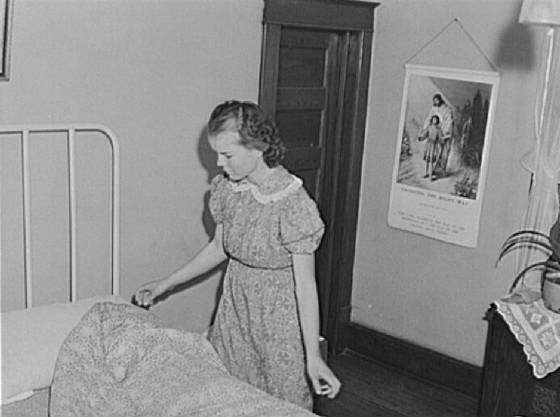
John Vachon caption: Farm girl making bed. McIntosh County, North Dakota, November 1940.
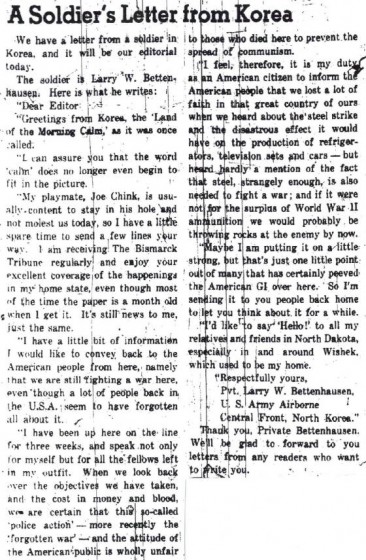
“There were the times during the Korean War when we would listen to the 6 o’clock news every night to hear the reports of the fighting. We always thought of Howard and Larry during that time and wondered if they were OK.” -Richard Bettenhausen

John Vachon caption: Mrs. Bettenhausen in her kitchen. McIntosh County, North Dakota, November 1940.
“I can see Mother so clearly standing by the stove cooking something, and Dad walking up behind her giving her a hug and kiss. She would smile at him, a loving, tender smile, which only meant, ‘I love you.'” -Mabel Bettenhausen
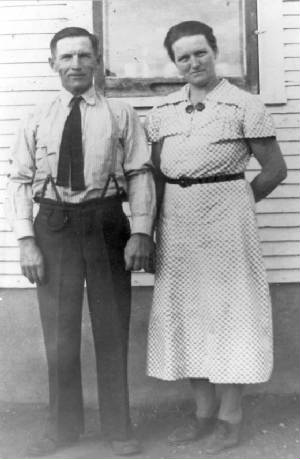

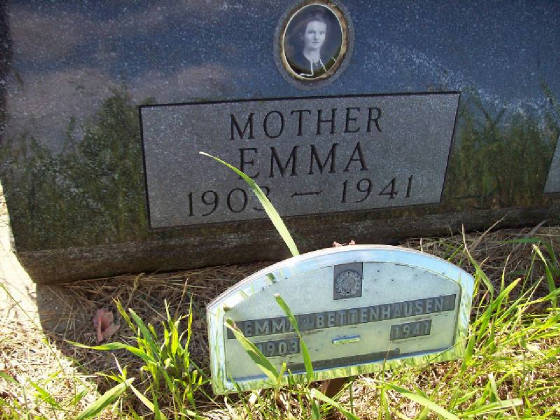
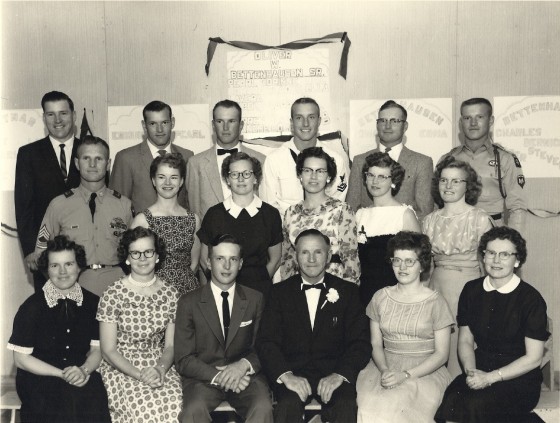
(Back row L-R): Warren, Larry, Oliver Jr, Neil, Charles, Edgar
(Middle row L-R): Howard, Corrine, Muriel, Blanche, Shirley, Gladys
(Front row L-R): LaVera, Mabel, Richard, Oliver Sr. (father), Ella, Pearl
The following are excerpts from Childhood Memories, which are family reunion booklets compiled in 1990 and 2005. I have chosen contributions from nine of the children: Pearl, Mabel, LaVera, Blanche, Warren, Charles, Shirley, Neil and Ella. Some are long, some are short, some are funny, and some are sad. All are compelling and richly detailed accounts of a family that experienced, and contributed to, the great events of the 20th century. Most are handwritten, but can be easily understood. Of particular note is Mabel’s five-page chronicle, which becomes an indispensable document, both for the family and for historians. And don’t miss Ella’s charming anecdote, which in its own simple way, exemplifies her family’s enduring bonds. I saved this one for last. We owe the Bettenhausen family a debt of gratitute for sharing these with us. (Click each one to enlarge to readable size).
At their request, I have donated a copy of this story and my research materials to the State Historical Society of North Dakota, in Bismarck. Richard Bettenhausen, whose interview appears in the story, has donated copies of the Bettenhausen family reunion booklets, excerpts from which are included in this story. Thus the family is now recognized as an important part of North Dakota history.
*Story published in 2012.
Detailed history of McIntosh County, North Dakota, and its population of German-speaking immigrants
